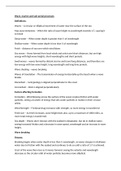Wave, marine and sub-aerial processes
Definitions:
Waves – A circular or elliptical movement of water near the surface of the sea
Max wave steepness – When the ratio of wave height to wavelength exceeds 1:7, causing it
to break
Deep-water – When water depth is greater than ¼ of wavelength
Shallow-water – When water depth is less than ¼ of wavelength
Fetch – distance of sea over which wind blows
Sea waves – those formed from local winds and only travel short distances, but are high
energy with high wave heights, short wavelengths and short periods.
Swell waves – waves formed by distant storms and travel long distances, and therefore are
low energy with low wave height, long wavelength and long time periods.
Wave shoaling – waves breaking
Waves of translation – The transmission of energy horizontally up the beach when a wave
breaks
Discordant – rock/geology is aligned perpendicular to the coast
Concordant – Rock is aligned perpendicularly
Factors affecting formation
Formation - Wind blowing across the surface of the ocean creates friction with water
particles, seeing a transfer of energy that sets water particles in motion in their circular
orbits.
Wind Strength – Frictional drag increases with strength, so more energy is transferred
Fetch size – As fetch increases, wave height does also, up to a maximum of 1000 miles, as
more total energy is transferred.
Sea depth – Waves don’t interact with the seabed in deepwater, but do in shallow water,
seeing increased friction and a decrease in wave speed, wavelength and an increase in wave
height.
Wave breaking
Process:
Breaking begins when water depth is less than ½ wavelength, as waves steepen in shallower
water due to friction with the seabed and continues to do so until a ratio of 1:7 is achieved.
Crest of the wave then rises as it moves forward, seeing the velocity and wavelength
decrease as the circular orbit of water particles becomes more elliptical.
,It will break when this ratio is exceeded as the top overtakes the bottom and starts to spill
forward. The wave breaks and moves up the beach in the swash.
Types of breakers (see notes for diagrams):
Spilling breaker
Break far from the shore on beaches with gentle gradients. Characterised by a gradual
peaking of the wave until the crest becomes unstable, causing a gentle spilling forward of
the crest. They are steep waves relative to wavelength. Much of their energy is disipated as
water travels across the beach.
Plunging breaker
Occur on steeper beaches, producing waves of intermediate steepness. Distinguished by the
shore-ward face of the wave becoming vertical, curling over and plunging forward and
downward as an intact mass of water
Surging breaker
Found on steep beaches with low steepness waves (as less friction so don’t get higher). The
front face and crest of the wave remain relatively smooth as the wave slides directly up the
beach without breaking. A large proportion of wave energy is reflected at the beach
Which is most impactful on the slope?
A surging breaker will cause the most erosion because it slams into the beach at full speed.
Spilling and plunging breakers slow down as they drag across the seafloor, so their energy is
dissipated over a wider zone.
Types of waves:
Constructive:
Long wavelength: Up to 100m
Low frequency: 6-8/minute
Form with short fetch, as they’re small, low energy, flat waves with a long wavelength and
low frequency. Usually spilling breakers.
Strong swash, so material is carried up the beach, however weak backwash, often as water
rapidly percolates into the sand, so weak backwash, which is to weak to weaken swash.
Create shallow beaches
Destructive:
Short wavelength: Around 20m
High frequency: 10-14 per minute
Form with large fetch, so they’re large, steep, high-energy waves. Usually plunging breakers,
hence steep beach gradient.
, Near-vertical wave breaking creates a powerful backwash, which moves sediment down the
beach while reducing the effect of the following wave’s swash.
Some material is thrown up to form a storm beach, but most is moved downwards to form a
longshore bar
Create steep beaches, as large material pushed up the beach and smaller sediment washed
away.
Erosion
Definitions:
Hydraulic action – the sheer force of moving water exerts a pressure which can be
extremely strong in storms
Cavitation – The compression of air in openings of rock as the wave hits, followed by
decompression as the wave recedes. Meanwhile, the process weakens the structure and
increases the SA for further erosion.
Abrasion – load carried by the breaking waves is thrown against the rock
Attrition – Reduction in the size of the load carrier by waves as abrasion occurs between
particles
Solution – Occurs in calcareous rocks like chalk and limestone where carbonation-solution
creates soluble material which is carried away by the waves
Wave refraction – Process
1. Where waves approach a discordant coastline, they are refracted and become
increasingly parallel
2. As wavefronts approach the shore, their speed decreases due to friction with the
seabed, usually at headlands where the water is shallower
3. The portion of water in shallower areas is retarded in comparison to that of deeper
areas, causing the wave to bend
4. Wave energy then becomes concentrated upon the headline, where erosion is then
accentuated, while wave energy is dissipated in bays, so deposition occurs
Subaerial processes:
Aside from weathering done previously:
Biological – Molluscs, sponges, sea urchins and seabirds produce waste and guano which is
extremely corrosive.
Salt crystallisation – In the ‘spray zone’ towards the base of the cliff, water soaks into the
pores of rock, which evaporates and forms crystals. The crystal’s cube shape exerts on the
irregular pores, causing decomposition and crumbling.
Mass movement:




